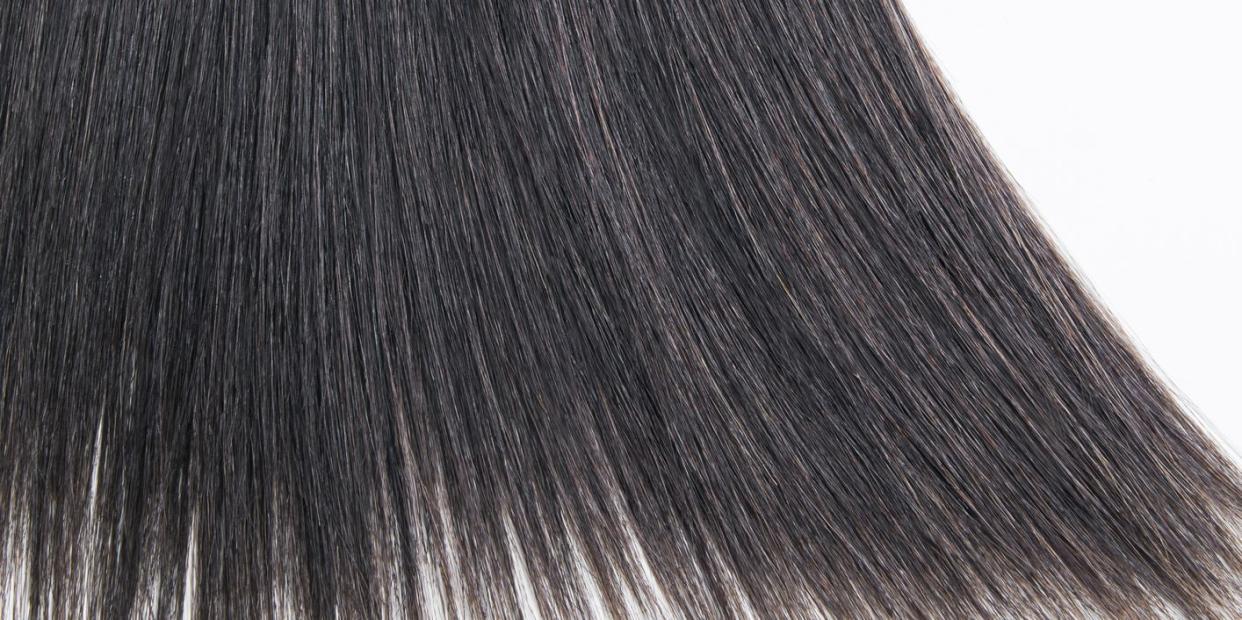A Stylist's Guide to The Perfect Silk Press

If you regularly flat iron your naturally curly hair at home then you know all about silk presses, a temporary hairstyle that takes those results and elevates them to glossier—and yes, silkier—heights. “A silk press makes natural hair very straight, shiny, silky, and soft,” says hairstylist and colorist Chrissy Zemura. “It gives a lot of body and movement without using a relaxer or the chemicals that straighten hair.”
Though achievable at home with the right tools, technique, and products, there’s still a reason that hair professionals specialize in the silk press technique and offer it in-salon, since there’s four major steps to it. Ahead, learn how a pro performs a silk press, how to make the style last longer, and what you should know before booking an appointment.
What Is a Silk Press?
“The procedure has been around for a very long time, but the name came from a play on words: pressing the hair with a flat iron to make it silky smooth,” explains Zemura. “It is temporary and hair will revert back to its natural state.”
How To Do a Silk Press
According to the hairstylist, there are four steps to creating the type of glossy, bouncy silk presses that pop up on the Instagram Explore page. First, break out the deep cleansers. “Hair must be thoroughly washed to remove any product buildup and dirt. This will allow you to get a silk press with body and movement,” says Zemura, who recommends using a clarifying shampoo like O&M’s Original Detox Shampoo.
The next step—deep conditioning—plugs moisture back into the equation and results in that jaw-dropping silk press shine later on. “Hair must be well conditioned and hydrated before any heat process. This will help your silk press reach its full potential,” adds the stylist. “A deep-conditioning treatment should be on the hair for at least 15 minutes with a hot towel or a steaming cap, then rinsed off with cool water to seal the cuticle. This locks in all the good ingredients and allows your hair to lay flatter.”
The heat tools come after that, beginning with a deep and hydrated blow-dry. “When blow-drying your hair, you want to make sure you get the hair—roots to ends—bone dry. There should not be any moisture left on the hair,” Zemura continues.
The initial blow-dry is when you should begin incorporating brushes, heat protectants, and hydrating mists as well: “Depending on the curl type you’re working on, you can use various brushes. When working with 4a through 4c I use a paddle brush, but when working with 3c and below I use a large round brush,” she says. While Zemura notes that refraining from packing on too much product is “the secret to achieving a lightweight silk press,” she still says a heat protectant is “non-negotiable” since it shields hair from heat tools, and that a light hydrating mist “gives the hair a natural shine and hydration without weighing the hair down.”
Now is time for the actual “press” itself, where you or your stylist will build upon your healthy, hydrated, and heat-protected base. “I always recommend people to use flat irons with titanium plates,” adds Zemura. “These distribute heat more evenly than ceramic or other flat irons.”
At the end, what separates a well-performed silk press from a so-so one—and what you should be looking for from your stylist—is how your hair feels afterwards. “The hair should have lots of body and movement,” Zemura notes. “A silk press shouldn’t be stiff!”
How Do You Maintain a Silk Press?
Here’s the good news: after all that, Zemura says that your silk press can last “with proper care” up to two to three weeks. But as with any straightened style, you need to factor in the weather. “It all depends on a person’s lifestyle and the climate,” she says. “I don’t recommend getting a silk press when there’s over 25% humidity—it will be a waste of time and money.”
Minimize your hair's exposure to water overall, too. “I suggest wrapping the hair at night, wearing a shower cap—definitely no swimming!” Zemura adds. Naturally, this means washing your hair will get rid of the style, too, though Zemura points out that “you receive a good wash before your silk press” and 4a through 4c curl types are less likely to feel oily compared to 3c and below.
Silk Press Hair Tips
Those aren’t the only kernels of stylist wisdom to keep in mind once you have a silk press—or before you even have one. And if you want a silk press so glossy it could catch a satellite’s attention, you need to factor in how you’re taking care of your hair before you plop down in a stylist’s chair. “Ultimately, healthy hair can achieve that beautiful shine. So one should make sure that their hair is healthy and hydrated in order to get the best out of their silk press,” says Zemura.
Likewise, your hair needs to be “double the width of the flat iron” in length to achieve a silk press, she notes. This ends up being important later if you want to touch up your silk press on your own: “You could lightly press the hair on low heat after a week or so if you think it needs it, using a heat protectant of course.”
The most important advice to remember, though? “A silk press is something to do once in a while to switch up your style," says Zemura. "It’s not a bi-weekly salon appointment—this is where damage can happen."
You Might Also Like

